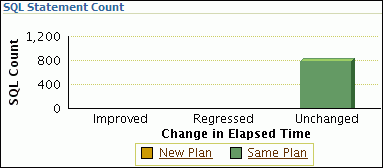Review the chart in the Projected Workload Elapsed Time subsection.
Note:
The name of the subsection may vary based on the comparison metric that is selected.
The chart shows the two trials on the x-axis and the elapsed time (in seconds) on the y-axis.
The most important statistic is the overall impact, which is given as a percentage. The overall impact is the difference between the improvement impact and the regression impact. You can click the link for any impact statistic to obtain more details, as described in "Reviewing the SQL Performance Analyzer Report: Global Statistics Details".
In this example, the improvement impact is 20%, while the regression impact is -2%, so the overall impact of the system change is an improvement of approximately 18%. This means that if all regressions are fixed in this example, the overall impact of the change will be an improvement of 20%.
Note:
The overall impact percentage may sometimes be off by 1% compared to the sum of the improvement impact and the regression impact. This discrepancy may be caused by rounding or if the SQL and workload time limits are set at 1%, which is the recommended value. This enables the analysis to focus on SQL statements with higher impact by filtering out those that have a minimal impact.
Review the chart in the SQL Statement Count subsection.
The x-axis of the chart shows the number of SQL statements whose performance improved, regressed, or remain unchanged after the system change. The y-axis shows the number of SQL statements. The chart also indicates whether the explain plans changed for the SQL statements.
This chart enables you to quickly weigh the relative performance of the SQL statements. You can click any bar in the chart to obtain more details about the SQL statements, as described in "Reviewing the SQL Performance Analyzer Report: Global Statistics Details". Only up to the top 100 SQL statements will be displayed, even if the actual number of SQL statements exceeds 100.
In this example, all SQL statements were unchanged after the system change.

